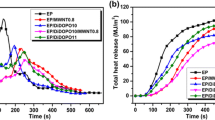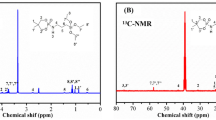Abstract
The thermal degradation and flame retardancy effect between ionic liquid-modified graphene and hexaphenoxy cyclotriphosphazene on epoxy resin (EP) was investigated using thermogravimetric analysis, differential thermogravimetric analysis, thermogravimetric analysis-infrared spectrometry (TGA-FTIR) and the char residue analysis. The carbonization and synergistic flame-retardant mechanism were obtained. The results showed that, compared with pure EP, the char residue amount of flame-retardant EP was increased, which was dense and continuous with fewer and smaller pores. This was due to the compatibilization of the ionic liquid to the matrix, resulting in the good dispersion of the flame retardant in EP matrix to promote the carbonization efficiency. The TGA-FTIR analysis showed that the PO·and HF free radicals produced by decomposition of flame retardants quenched the flame in the gas phase, and the produced water vapor and NH3 diluted the concentrations of combustible gas and oxygen to inhibit the progress of combustion.
Graphical abstract






Similar content being viewed by others
References
Zheng PL, Wang R, Wang DH, et al. A phosphorus-containing hyperbranched phthalocyanine flame retardant for epoxy resins. Sci Rep. 2021;11(1):17731.
Szeluga U, Pusz S, Kumanek B, et al. Effect of graphene filler structure on electrical, thermal, mechanical, and fire retardant properties of epoxy-graphene nanocomposites-a review. Crit Rev Solid State Mater Sci. 2021;46(2):152–87.
Li JH, Wu WH, Meng WH, et al. Nickel ammonium phosphate nanowires modified g-C3N4 for improving the fire safety of epoxy resin. Fibers Polym. 2021;22(10):2664–72.
Zhou X, Qiu SL, Mu XW, et al. Polyphosphazenes-based flame retardants: a review. Composites Part B Eng. 2020;202:108397.
Xu JZ, He Z, Wu W, et al. Study of thermal properties of flame retardant epoxy resin treated with hexakis p-(hydroxymethyl)phenoxy cyclotriphosphazene. J Therm Anal Calorim. 2013;114(3):1341–50.
Yang YY, Kong WB, Cai XF, et al. Synthesis of tris(phenoxy)trifluorocyclotriphosphazenes and study of its effects on the flammable, thermal, optical, and mechanical properties of bisphenol-A polycarbonate. J Therm Anal Calorim. 2015;122:805–16.
Kong QH, Zhu HJ, Huang S, et al. Influence of multiply modified FeCu-montmorillonite on fire safety and mechanical performances of epoxy resin nanocomposites. Thermochim Acta. 2022;707:179112.
Ding JM, Zhang Y, Zhang X, et al. Improving the flame-retardant efficiency of layered double hydroxide with disodium phenylphosphate for epoxy resin. J Therm Anal Calorim. 2020;140:149.
Zhang JH, Kong QH, Wang DY, et al. Simultaneously improving the fire safety and mechanical properties of epoxy resin with Fe-CNTs via large-scale preparation. J Mater Chem A. 2018;6(15):6376–86.
Kong QH, Sun YL, Zhang CJ, et al. Ultrathin iron phenyl phosphonate nanosheets with appropriate thermal stability for improving fire safety in epoxy. Compos Sci Technol. 2019;182:107748.
Liu QY, Zhao YL, Gao SS, et al. Recent advances in the flame retardancy role of graphene and its derivatives in epoxy resin materials. Composites Part A Appl Sci Manuf. 2021;149:106539.
Wang X, Kalali EN, Wan JT, et al. Carbon-family materials for flame retardant polymeric materials. Prog Polym Sci. 2017;69:22–46.
Kalali EN, Guo W, Wang X, et al. Effect of metal-based nanoparticles decorated graphene hybrids on flammability of epoxy nanocomposites. Composites Part A Appl Sci Manuf. 2020;129:105694.
Liu X, Wu W, Qi Y, et al. Synthesis of a hybrid zinc hydroxystannate/reduction graphene oxide as a flame retardant and smoke suppressant of epoxy resin. J Therm Anal Calorim. 2016;126(2):5539.
Yu B, Shi Y, Yuan B, et al. Enhanced thermal and flame retardant properties of flame-retardant-wrapped graphene/epoxy resin nanocomposites. J Mater Chem A. 2015;3(15):803444.
Yue X, Li C, Ni Y, et al. Flame retardant nanocomposites based on 2D layered nanomaterials: a review. J Mater Sci. 2019;54(20):13070105.
Kabeb SM, Hassan A, Mohamad Z, et al. Effect of graphene nanoplatelets on flame retardancy and corrosion resistance of epoxy nanocomposite coating. Malaysian J Fundam Appl Sci. 2019;15(4):543–7.
Wang X, Chen T, Peng C, et al. Synergistic Effect of mesoporous nanocomposites with different pore sizes and structures on fire safety and smoke suppression of epoxy resin. Macromol Mater Eng. 2019;305(2):1900640.
Zhang KL, Chen YY, Yao M, et al. The preparation of ionic liquid doped graphene composite and its synergistic flame retardant effect with hexaphenoxy cyclotriphosphazene on epoxy resin. Scientia Sinica Chimica. 2021;51(9):1283–92.
Xu JZ, Liu CH, Qu HQ, et al. Investigation on the thermal degradation of flexible poly(vinyl chloride) filled with ferrites as flame retardant and smoke suppressant using TGA-FTIR and TGA-MS. Polym Degrad Stab. 2013;98(8):1506–14.
Chen YY, Wu HJ, Duan R, et al. Graphene doped Sn flame retardant prepared by ball milling and synergistic with hexaphenoxy cyclotriphosphazene for epoxy resin. J Market Res. 2022;17:774–8.
Yang G, Wu WH, Qu HQ, et al. Synthesis of a novel phosphazene-based flame retardant with active amine groups and its application in reducing the fire hazard of Epoxy Resin. J Hazard Mater. 2019;366:78–87.
Xue BX, Niu M, Yang YZ, et al. Multi-functional carbon microspheres with double shell layers for flame retardant poly (ethylene terephthalate). Appl Surf Sci. 2018;435:656–65.
Qiu S, Zou B, Sheng H, et al. Electrochemically exfoliated functionalized black phosphorene and its polyurethane acrylate nanocomposites: synthesis and applications. ACS Appl Mater Interfaces. 2019;11(14):13652–64.
Wu K, Zhang YK, Hu Y, et al. Effect of microencapsulation on thermal properties and flammability performance of epoxy composite. J Anal Appl Pyrol. 2012;94:196–201.
Luo HQ, Zhao P, Yu CB, et al. An efficient organic/inorganic phosphorusenitrogenesilicon flame retardant towards low-flammability epoxy resin. Polym Degrad Stab. 2020;178:195–203.
Kudashev SV, Shapovalov VM, Arisova VN, et al. Reducing the combustibility of polycaproamide using a mixture of polyelemental flame retardants. Fiber Chemistry. 2020;51(5):346–9.
Xu MJ, Xu GR, Leng Y, et al. Synthesis of a novel flame retardant based on cyclotriphosphazene and DOPO groups and its application in epoxy resins. Polym Degrad Stab. 2016;123:105–14.
Qu HQ, Wu WH, Xu JZ, et al. Intumescent flame retardancy and thermal degradation of epoxy resin filled with ammonium polyphosphate using thermogravimetric analysis-Fourier transform infrared spectroscopy and thermogravimetric analysis–mass spectrometry. J Macromol Sci Part B Phys. 2014;53:278–95.
Zhao P, Rao WH, Yu CB, et al. Novel organophosphorus compound with amine groups towards self-extinguishing epoxy resins at low loading. Mater Des. 2020;193:838–50.
Acknowledgements
This work was supported by the multidisciplinary research project of Hebei University [grant numbers DXK202003]; the Beijing Tianjin Hebei collaborative innovation community construction project [Grant Numbers 20541401D]; Open project of Hebei Provincial key laboratory of hazardous chemicals safety and control technology [Grant Numbers 20211204-3]
Author information
Authors and Affiliations
Corresponding author
Additional information
Publisher's Note
Springer Nature remains neutral with regard to jurisdictional claims in published maps and institutional affiliations.
Rights and permissions
Springer Nature or its licensor holds exclusive rights to this article under a publishing agreement with the author(s) or other rightsholder(s); author self-archiving of the accepted manuscript version of this article is solely governed by the terms of such publishing agreement and applicable law.
About this article
Cite this article
Chen, Y., Wu, W., Zhang, M. et al. TGA-FTIR and char residue analysis: studying the synergistic flame retardancy mechanism of ionic liquid-modified graphene and hexaphenoxy cyclotriphosphazene. J Therm Anal Calorim 147, 13253–13259 (2022). https://doi.org/10.1007/s10973-022-11615-x
Received:
Accepted:
Published:
Issue Date:
DOI: https://doi.org/10.1007/s10973-022-11615-x




